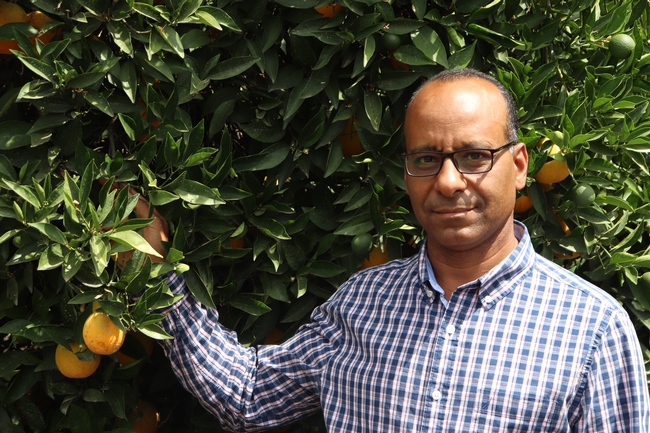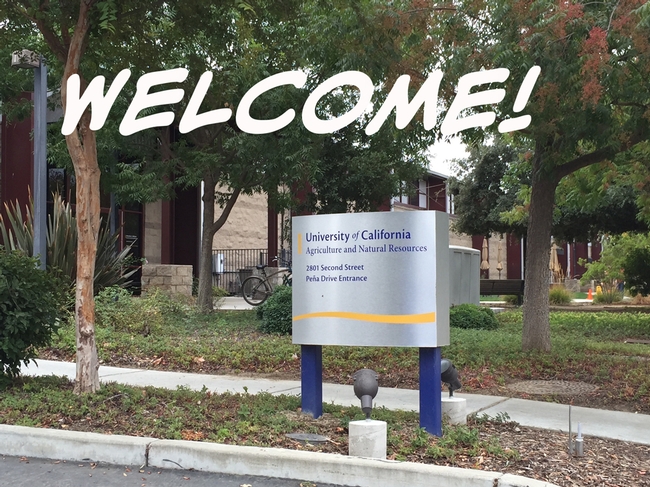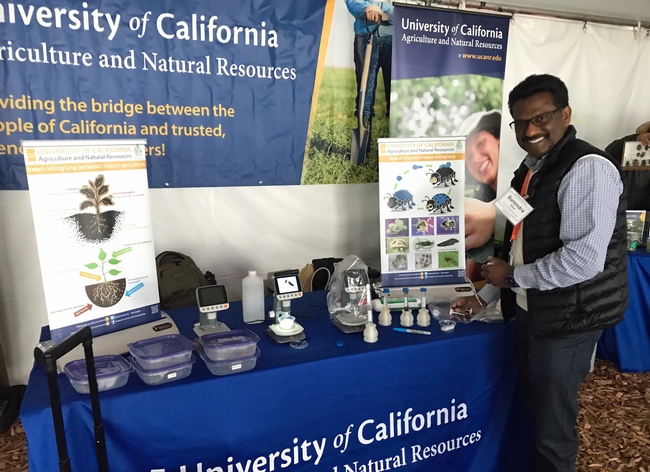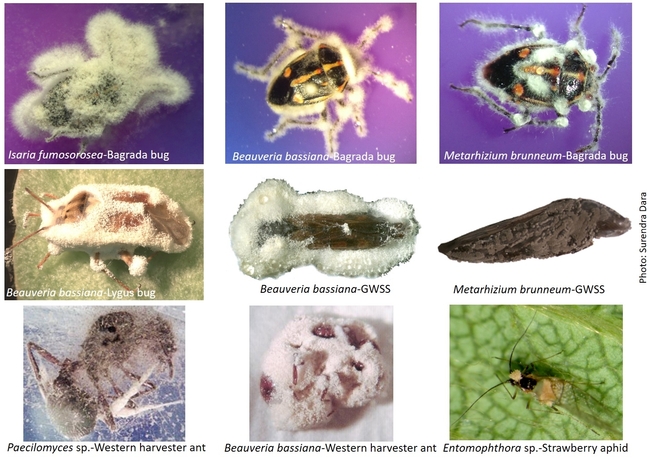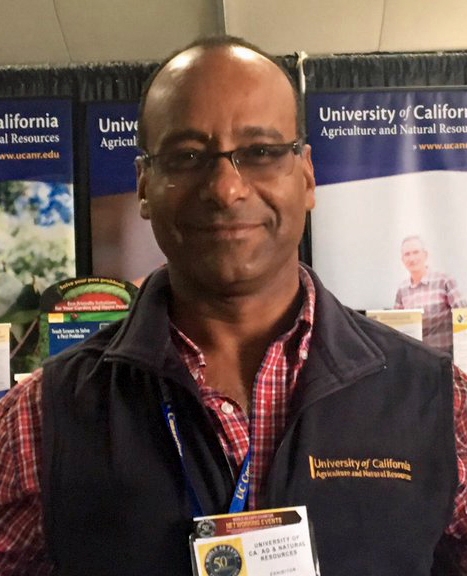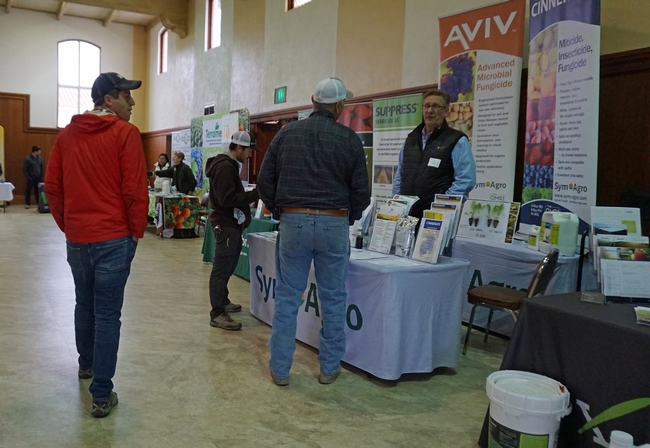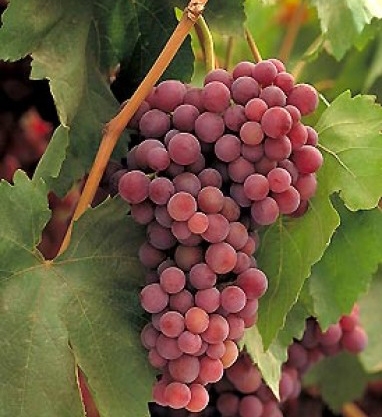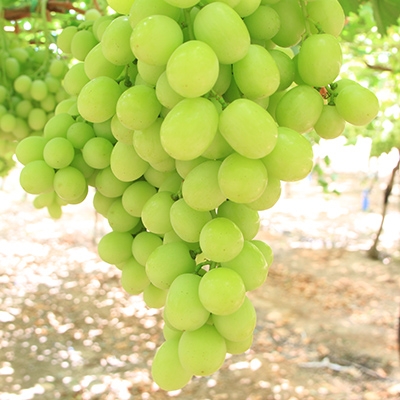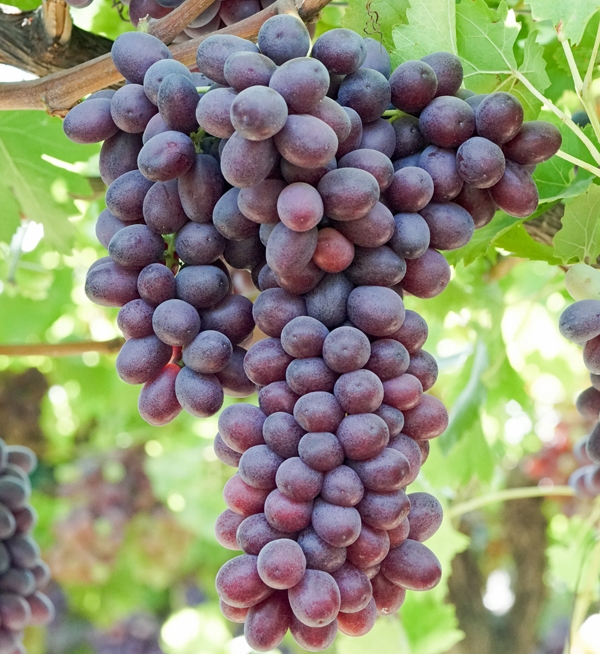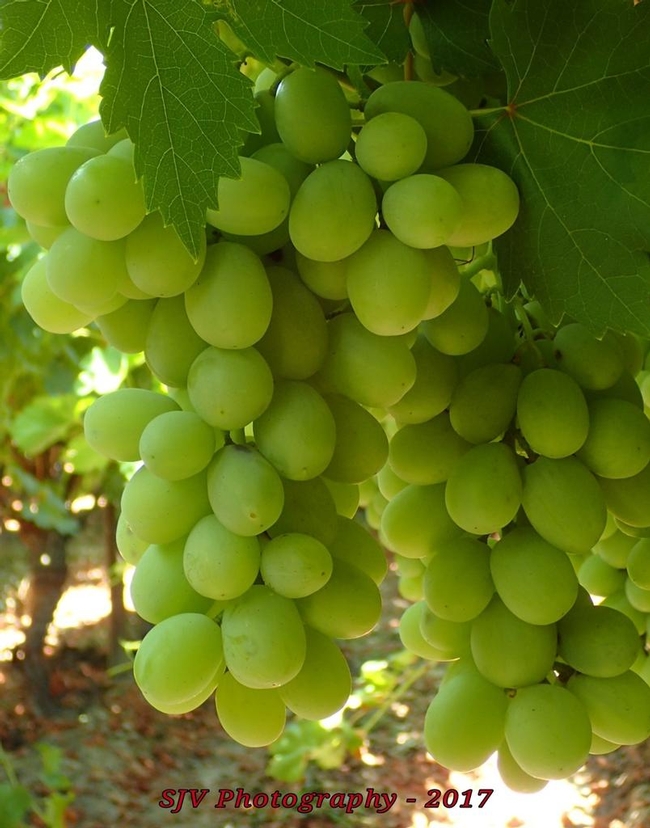Posts Tagged: Ashraf El-kereamy
El-kereamy named director of UC Lindcove REC
Ashraf El-kereamy will be the new director of UC Agriculture and Natural Resources' Lindcove Research & Extension Center, starting on July 1, 2020. He will continue to serve as a UC Cooperative Extension specialist in the Department of Botany and Plant Sciences at UC Riverside and based at Lindcove Research & Extension Center.
“Elizabeth Grafton-Cardwell retires this year after 13 years as director of Lindcove REC, California's premier citrus research center,” said Mark Lagrimini, UC ANR vice provost for research and extension. “We are excited to have Ashraf in place to carry on the tremendous success attributable to the research performed at Lindcove. Ashraf brings a breadth of research, extension and leadership skills.”
El-kereamy has extensive experience with several commodities with research revolving around plant hormones, fruit ripening, plant nutrition, and the responses of different plant species to abiotic stress conditions.
Since February 2019, El-kereamy has been serving as a UC Cooperative Extension citrus specialist based at Lindcove Research and Extension Center. Prior to the specialist position, El-kereamy was a UCCE viticulture and small fruit advisor for Kern County, where he established a research and extension program serving the San Joaquin Valley table grape industry for four years. Prior to joining UC ANR, he was an assistant/associate professor in the Department of Horticulture at Ain Shams University in Egypt.
“I am honored and very excited to be the director of Lindcove Research and Extension Center, which plays a crucial role in the California citrus industry,” El-kereamy said. “I am confident that, with the support of our industry, community and the University of California, we will build tomorrow's Lindcove REC as a center of excellence in research and extension. I am looking forward to leading Lindcove REC and providing our clientele with up-to-date technologies to cope with the challenges facing the California agriculture industry.”
El-kereamy earned a bachelor's degree in horticulture and master's degree in pomology from Ain Shams University in Cairo, Egypt, and a doctorate in agriculture with an emphasis in grapevine physiology and molecular biology from Toulouse University in France.
Seven academics take new positions with UC ANR during the first three months of 2019
Ashraf El-Kereamy named UCCE citrus specialist
Ashraf El-Kereamy was appointed UC Cooperative Extension citrus horticultural specialist in the Department of Botany and Plant Sciences at UC Riverside on Feb. 1, 2019. He is based at the UC Lindcove Research and Extension Center in Exeter.
El-Kereamy had been working as a UCCE area viticulture advisor serving Kern, Tulare and Kings counties since 2014.
Prior to joining UCCE, El-Kereamy was a post-doc research associate at University of Guelph in Ontario, Canada, studying plant drought and heat stress tolerance in plants from 2013 to 2014, and studying the genotypes variation in nitrogen use efficiency and plant heat stress tolerance from 2008 to 2012. From 2012 to 2013, he was assistant/associate professor in the Department of Horticulture, Ain Shams University, Egypt, where he taught undergraduate and postgraduate courses for horticultural science and served as the principal investigator for a U.S.-Egypt joint collaborative research project between University of Wyoming and Ain Shams. As a post-doctoral scientist at the University of Guelph, El-Kereamy studied the pathogenesis-related proteins during plum fruit ripening. As a University of Manitoba post-doc, he studied the physiological role of abscisic acid in plants.
El-Kereamy earned his doctorate degree in agriculture with an emphasis in grape physiology and molecular biology at Toulouse University, in France, and a master's degree in pomology and bachelor's degree in horticulture, both from Ain Shams University, in Cairo, Egypt.
El-Kereamy can be reached at (559) 592-2408, cell: (661) 703-4678 and aelkereamy@ucanr.edu. Follow him on Twitter at @ashrafelkereamy.
Giuliano Galdi joins UCCE in Siskiyou County
Giuliano C. Galdi joined UCCE on Jan. 2, 2019, as a UC Cooperative Extension agronomy advisor in Siskiyou County.
Prior to joining UCCE, Galdi was a junior specialist at UC Davis, where he worked on a variety of field trials aimed at improving sustainable water use and hay quality. Tasks included irrigation scheduling, planting/harvesting trials, and data handling and analysis. As a master's student and student research assistant at Fresno State, Galdi evaluated salinity tolerance in different alfalfa varieties and presented research in the form of posters and talks. He speaks Portuguese fluently.
Galdi earned a master's degree in plant sciences from Fresno State and a bachelor's degree in agronomy engineering from University of Sao Paulo, Brazil.
Galdi is based in Yreka and can be reached at (530) 842-2711 and gcgaldi@ucanr.edu.
Follow him on Instagram and Twitter at @uccesiskiyou.
Ian Grettenberger joins UCCE as field and vegetable crops specialist
Ian Grettenberger joined UCCE on Jan. 2, 2019, as a field and vegetable crops assistant specialist in the Department of Entomology and Nematology at UC Davis. Grettenberger is interested in advancing integrated pest management in field and vegetable crops, plant-insect interactions, and applied insect ecology.
Grettenberger earned a doctorate degree in entomology from Penn State University and a bachelor's degree in biology from Western Washington University.
Prior to joining UCCE, Grettenberger was a postdoctoral research scholar at UC Davis, working first with UCCE entomology specialist Larry Godfrey and then UCCE entomology specialist Frank Zalom.
Grettenberger is based at UC Davis in Briggs Hall and can be reached at (530) 752-0473 and imgrettenberger@ucdavis.edu. Follow him on Twitter at @IGrett.
Yu Meng joins UCCE in Imperial County
Yu Meng joined UC Cooperative Extension on Jan. 2, 2019, as the youth, families and communities advisor serving Imperial County, UC Desert Research and Extension Center and communities near the U.S.-Mexico border. Her responsibilities will focus on providing community development programs in the area of youth, families and communities, with major outreach to Latino youth and families.
Prior to joining UCCE, Meng worked for a USDA-funded project known as "the WAVE~Ripples for change" in collaboration with Oregon State University professionals, extension, community partners, high school soccer coaches, school districts and other volunteers. The program was designed to prevent unhealthy weight gain among 15- to 19-year-old soccer players. Most of the youth she worked with were Latinos and from low-income families. During this time, Meng helped develop and test the first sports nutrition, physical activity, family and consumer sciences curriculum for active youth. Her work resulted in positive developments in youth, reducing added sugar intake, maintaining fruit and vegetable intake over time, and improving the awareness of sports nutrition. Participating youth also applied additional skills they learned from gardening and cooking workshops at their homes, and shared the lessons and practical applications with their families.
Meng is fluent in Chinese and originally from China, where she worked for food industries and started to notice the nutrition issues with processed foods and their effects on children's health. With that in mind, she came to the U.S. and studied nutrition.
She completed a doctorate degree in nutrition science from Oregon State University, a master's degree in food science and nutrition from Utah State University, and a bachelor's degree in food science and engineering from Southern China University of Technology, China.
Meng is based in Holtville and can be reached at (442) 265-7700 and ucmeng@ucanr.edu.
Beatriz Nobua-Behrmann named UCCE advisor in urban forestry and natural resources
Beatriz Nobua-Behrman joined UC Cooperative Extension as an urban forestry and natural resources advisor serving Orange and Los Angeles counties on March 25, 2019.
As a UCCE staff research associate in Orange County since 2017, Nobua-Behrman provided management and direction to conduct a research and extension program focused on the impact of invasive insects on urban landscapes and wildlands surrounding urbanized environments. The main focus of the program was to conducting surveys of infestations in regional parks and open spaces in order to develop management strategies that are efficacious and economically feasible.
Nobua-Behrmann completed bachelor's and doctorate degrees in biology from the University of Buenos Aires in Argentina.
Nobua-Behrman is based at the UC South Coast Research and Extension Center in Irvine. She can be reached at (949) 301-9182, Ext. 1006, benobua@ucanr.edu.
Ryan Tompkins named forestry and natural resources advisor
Ryans Tompkins joined UC Cooperative Extension as a forestry and natural resources advisor on March 18, 2019, serving Plumas, Sierra and Lassen counties. Prior to joining UCCE, Tompkins held forester positions with the U.S. Forest Service, worked in the fire effects program with the National Park Service and served as associate faculty in the Environmental Studies Department at Feather River College, teaching forest ecology and management.
Most recently, Tompkins served as the forest silviculturist and vegetation program manager at the Plumas National Forest, where he designed, planned and implemented landscape-scale forest restoration projects.
Tompkins earned master's and bachelor's degrees in forestry from UC Berkeley.
Tompkins can be reached at (530) 83-6125, retompkins@ucanr.edu.
Robert York joins UCCE as silviculture and forest specialist
Robert York joined UC ANR on Jan. 2, 2019, as a UC Cooperative Extension silviculture and applied forest ecology assistant specialist and adjunct associate professor of forestry in the Department of Environmental Science, Policy and Management at UC Berkeley. He directs research and management activity on the Berkeley Forests, a network of five research forests covering the western slopes of the Sierra Nevada mixed conifer forest from Shasta to Tulare counties.
York is a Registered Professional Forester in California. He earned a doctorate degree in forest ecology and silviculture, a master's degree in forest community ecology and a bachelor's degree in forest management, all from UC Berkeley.
Prior to joining UCCE, York has been the research station manager at Blodgett Forest Research Station with UC Berkeley.
York is based in Georgetown and can be reached at (530) 333-4475 and ryork@berkeley.edu.
UCCE research seeks biological solutions for the agriculture industry
UC Cooperative Extension plays an active and ongoing role in the effort to increase agricultural sustainability and minimize the industry's environmental impact, a role that was showcased at the third Ag Innovations Conference in March. Held in Santa Maria, the event was centered on the potential for using biological solutions for the challenges faced in agricultural production – such as pest control and nutrient management.
Many organic growers are already using these products successfully. Conference organizer Surendra Dara, UCCE advisor in Santa Barbara and San Luis Obispo counties, believes increasing the use of biologicals in conventional agriculture, which represents a much larger part of the industry, holds promise for reducing the use of chemical pesticides, cutting back nitrogen inputs and sequestering carbon in healthy farmland soil.
The market for biologicals in agriculture is growing. Organic farming is increasing in acreage because of consumer demand for food grown without synthetic inputs. In the conventional sector, farmers are wary of the new biological projects, probably because of past experiences with “snake oil” products that made glowing claims, but came up short. They are looking for scientific research that confirms their effectiveness.
“The most important thing we can do is remove the stigma about efficacy,” Dara said. “Conventional options are inexpensive and they are generally perceived to work better. It is a hard thing to shake.”
Finding funding for research in biologicals is another obstacle.
“Much more funding is available to research in conventional practices,” Dara said. “It's challenging for us. We must rely on industry support.”
Dara has conducted multiple studies demonstrating the potential of biologicals in crop production. At the March conference, he shared the results of experiments in tomato, strawberry and grape production in which he compared products containing seaweed extracts, silicon and beneficial bacteria and fungi.
“Many of the treatments worked well,” Dara said. “We saw some improved yield and good pest control.”
Research results are a key for mainstreaming biologicals in the ag industry, said Bill Schwoerer a speaker at the conference who represents Concentric Ag in San Luis Obispo, a company that produces biological optimizers for soil, seed and plant vigor. Concentric and other companies that are marketing biologicals said expectations need to be managed.
“It's not a silver bullet,” he said. “It's a tool to help you farm and produce a better crop.”
Concentric's product is a unique metabolite brew that contains seven bacteria and three fungi.
“It mimics a healthy soil microbiome,” Schwoerer said. “It's important to note, with these products, we see more improvements under stress conditions. That's the nature of the product.”
Ashraf El-kereamy, the former UCCE viticulture advisor in Kern County who was recently promoted to UCCE specialist at the UC Lindcove Research and Extension Center, presented results of his first year of research on seaweed extract applications on Flame seedless and Allison grape varieties in Kern County.
The products are derived from wild and cultivated seaweed from oceans around the world. Their potential as agricultural inputs stem from seaweed's rapid cell division and growth, a function that is controlled by natural plant hormones.
In a commercial vineyard, El-kereamy compared 11 compounds that represent most of the seaweed products on the market. The vines were treated according to label directions with at least three applications during the growing season. After the crop was harvested, El-kereamy compared berry weight, length and diameter, and found no significant differences. Sugar content, acidity and the firmness also were not impacted by the seaweed products. But in the comparison of hue angle, a measure of berry color, the research showed that most seaweed extracts prompted the grapes to increase in redness.
“Increasing color on red seedless grapes is important for marketing,” El-kereamy said. “Growers in the southern San Joaquin Valley are having an issue with coloring. Some growers had to dry their red grapes to raisins or sell to the juice companies because stores didn't accept the crop without good color.”
The research results are preliminary. And more potential impacts of the seaweed products still need to be studied – such as the impact on vine growth and stress tolerance, and the impact of the compounds on grapes grown in other areas or in different varieties.
But El-kereamy is encouraged by the early findings. The increased value of the redder grapes more than offsets the cost of the seaweed treatment, he said.
Other speakers representing firms that produce biological compounds for the ag industry also shared information at the Ag Innovations Conference:
- Paul Zorner, chief executive officer of Locus Agricultural Solutions, said the products made by the company target the soil microbiome and focus on high-value horticultural crops. The company has found that their probiotic supports more robust, consistent root growth by creating better nutrient status and a better microbial environment.
- Drew Jackson, vice president of Cool Planet, shared information about biochar, a product made by burning organic matter in an oxygen-deprived environment. He said biochar has unique properties that lend themselves healthy soil biology. “It's like luxury condos for microbes,” Zorner said.
- Antonin van der Lely of Biobest USA is working to move biocontrols that are used successfully in the greenhouse industry into outdoor agriculture.
- Katherine Walker, a technical service representative for BASF, discussed a biological fungicide from the company that can suppress root and foliar fungus. The product, called Serifel, can be used along with a chemical fungicide for added protection and resistance management.
- Melissa O'Neal of Marrone Bio Innovations presented information about two new Marrone products, Stargus and Ennoble. These products can also be used to alternate with conventional products to prevent resistance, she said. Stargus is a liquid fungicide that can inhibit botrytis in grapes and strawberries, sclerotinia in lettuce and downy mildew in lettuce. Ennoble is a granular bio fumigant that is incorporated into the soil, where it releases volatiles into plants' rootzones.
- Deb Shatley of Terramera said the company is formulating a product with cold-pressed neem oil that mixes with water in an application tank and stays in solution for days. Neem is a tree native of India and other South Asian countries that is a natural miticide, fungicide, insecticide and nematicide. The Terramera product, called Rango, provides more consistent neem spray coverage in the field.
May 2018 News Clips
Mien farmers get advice for growing strawberries in Yolo County
(Woodland Daily Democrat) ANR news release, May 31
Abnormal Weather Takes a Toll on California Olive Crop
(Ag Net West) Brian German, May 30
The late winter freeze caused significant issues for several different commodities throughout the state and has been especially problematic for the California olive crop. The fluctuating temperatures have created substantial concern among the industry as bloom looks to be far below normal levels.
“Overall we're a little on the pessimistic side. The bloom, on the whole, has been pretty poor, many orchards actually have a very light, to next to no bloom at all,” said Dani Lightle, Cooperative Extension Orchard Systems Advisor for Glenn County. “There's an orchard here or there that looks pretty good, but on the whole, it is a little bit dismal.”
http://agnetwest.com/weather-takes-toll-california-olive-crop/
How Avocados Define LA and the Secret to Making the Best Damn Avocado Toast
(LA Taco) Gab Chabran, May 29
…Eric Focht who is a staff research associate in the lab of Mary Lu Arpaia at UC Riverside through UC Agriculture and Natural Resources and the Department of Botany and Plant Sciences tells L.A. Taco that the recent avocado economy boom is “similar to what we see today with something like bitcoin.” He helps run a breeding program at UCR studying different avocados varieties, focusing mostly on Hass avocados but also looking at other less known versions of the popular fruit.
In short, he is working on breeding the perfect avocado that tastes great and is easier, faster, and less water-dependent to grow. This year is shaping out to be a good one for avocados, but this issue is always one to keep in mind.
Focht states that in the future, there will likely be more variety available in the mainstream marketplace. One varietal that Focht gets excited about is the Reed avocado which has now been popping up in places such as Whole Foods. It's known for its round, dinosaur egg shape and is about the size of a softball. It has a relatively large seed but the edible flesh is sometimes double or even triple that of a Haas that can make a lot more people happier per individual fruit.
http://www.lataco.com/how-avocados-define-l-a-and-the-secret-to-making-the-best-damn-avocado-toast/
Amazing graze
(Chico News & Review) Ashiah Scharaga, May 24
When drifting clouds dapple the sky and vibrant wildflowers—tickled pink buds, honey-hued petals and virent stems—awaken in the verdant fields of Table Mountain, explorers quicken their pace. They spot trickling streams and grazing cattle. Occasionally, they look straight down, turning anxious eyes to their mud-slicked heels—did they step in one of the fertile cow-pie mines littered across the landscape?
That may seem a nuisance, but it's a necessity. Tracy Schohr, a livestock and natural resources adviser for University of California Cooperative Extension, said the natural magic of the popular Butte County recreational spot is made possible because of a long-standing grazing program. “If cattle were not actually on Table Mountain Ecological Reserve,” she said, “essentially those invasive species would choke out those native plants, and they wouldn't be there.”
… In the past, grazing was misunderstood and primarily viewed as destructive, said Dave Daley, a fifth-generation Butte County cattleman and associate dean of Chico State's College of Agriculture. He credits changing perspectives to the development of grazing science, fueled by people such as Schohr and Kate Wilkin, a UC Cooperative Extension forestry, fire science and natural resource adviser for Butte, Yuba, Sutter and Nevada counties. (Schohr covers Butte, Plumas and Sierra counties.)
https://www.newsreview.com/chico/amazing-graze/content?oid=26315855
Sheep Shearing 101: Why Aspiring Shavers Flock to This California School
(KQED) Tiffany Camhi, May 23
…“We try to get the students shearing the first day because they make a lot of mistakes,” says John Harper, head of the UC Cooperative Extension Sheep Shearing School in Hopland.
Harper says if you can make the right moves with your feet, everything else falls into place.
“We're dancing instructors,” says Harper. “It's like 'Dancing With The Stars' on steroids, but with sheep.”
Around this time of year, hundreds of thousands of sheep in California need to have their wool shaved off. But Harper says there's a shortage of sheep shearers worldwide.
That's why he started the school in Hopland about 25 years ago.
Dan Macon of the California Wool Growers Association says the growing popularity of backyard flocks in California (usually just a handful of sheep) is adding to the demand for shearers, too.
“Infrastructure of the sheep industry is a key component,” says Macon. “Having people with that kind of skill and willingness to work hard is desperately needed.”
AUDIO: Hey, Salad Lovers: It's OK To Eat Romaine Lettuce Again
(NPR Morning Edition) Allison Aubrey, May 23
…After a big foodborne illness outbreak linked to baby spinach back in 2006, the leafy greens industry put in place a number of procedures to prevent contamination. "Prevention became the major focus after that outbreak," says Michele Jay-Russell, a food safety researcher at the University of California, Davis.
"They set up intensive testing protocols to monitor water quality," Jay-Russell says. The industry also agreed on standardized setbacks — or buffers — to separate growing fields from livestock operations, which can be a source of E.coli contamination. "You want a safe distance from where you're growing fresh produce and where you have concentrations of animals, like on a feedlot or dairy," she says.
Are avocados toast?
(Grist) Nathanael Johnson, May 22
…When Katherine Jarvis-Shean was a doctoral candidate researching the decline of cold winters a few years back, she thought more farmers should be freaking out. “I used to think, ‘Why aren't you guys more worried about this? It's going to be the end of the world.'”
After all, many fruit and nut trees require a good winter chill to bear fruit. But after spending a few years as an extension agent for the University of California — working directly with farmers and translating science into techniques they can apply on the land — she understands better. It comes down to this: Farmers have a ton of concerns, and the climate is just one of them.
“If you decide what to plant based on climate, but then can't make the lease payment, that's not sustainable,” Jarvis-Shean said.
https://grist.org/article/whatll-we-eat-in-2050-california-farmers-are-placing-bets/ https://www.wired.com/story/are-avocados-toast/
Lanternflies Eat Everything in Sight. The U.S. Is Looking Delicious.
(New York Times) Zach Montague, May 21
…Native to Asia, lanternflies first appeared in Pennsylvania in 2014. Despite a quarantine effort, they have also been discovered in small numbers in New York, Delaware and Virginia.
… “Most pests deposit their eggs on their host plant, or very close, so they already have food available,” said Surendra Dara, an adviser at the University of California Cooperative Extension.
“Those that have the advantage of being able to lay eggs on non-plant material obviously have a better chance of surviving and spreading,” he added.
https://www.nytimes.com/2018/05/21/science/lanternflies-pennsylvania-crops.html
Garbanzos are catching on in Yolo County
(Woodland Daily Democrat, Ag Alert) Bob Johnson, May 19
…“The largest part of our crop goes to canning, maybe 90 percent,” said Paul Gepts, UC Davis plant sciences professor and legume breeder. “California can only compete with high quality products. We have other varieties with higher yields, but the seeds are too small. The growers get a premium for larger, high quality seeds.”
Gepts developed the two newest UC garbanzo varieties, Vega and Pegasus. Both have large, attractive seeds well suited for the canning market, and both have resistance to Ascochyta blight, a fungal disease that can devastate the crop.
… “I think growers are more interested in garbanzos because it's a winter crop, and wheat prices are low,” said Rachael Long, UC Cooperative Extension farm adviser in Sacramento, Solano and Yolo counties. Long is finishing up UC's first Garbanzo Production Manual, which should be available before the end of the year.
http://www.dailydemocrat.com/article/NI/20180519/NEWS/180519787
A French Broom smack-down
(Napa Valley Register) Elaine de Man, May 18
…If we all pull together and pay attention, we can eradicate French broom and send it packing. But it's going to take many, many hands and a concerted effort. It's going to take a village.
1. U.C. Agriculture and Natural Resources, Statewide Integrated Pest Management Program, http://ipm.ucanr.edu/PMG/PESTNOTES/pn74147.html
Kale, Not Jail: Urban Farming Nonprofit Helps Ex-Cons Re-enter Society
(New York Times) Patricia Leigh Brown, May 17
Even by the standards of the Bay Area, where sourcing local, organic chicken feed is seen as something of a political act, the spectacle of 30,000 fruit and nut trees being tended by formerly incarcerated orchardists is novel.
…Jennifer Sowerwine, an urban agriculture specialist for the University of California Cooperative Extension at Berkeley, said that Ms. Haleh and Mr. Raders have “shifted the conversation around food justice.”
“It's not just about food security, but the security of providing living wages,” she said. That's no mean feat in a foodie monoculture.
https://www.nytimes.com/2018/05/17/business/urban-farming-exconvicts-recidivism.html
Tough winter weather devastates local cherry, blueberry crops
(Bakersfield Californian) John Cox, May 16
It's hard to say at this point just how much damage blueberry fields and cherry orchards sustained during the winter, said Ashraf El-kereamy, viticulture and small fruits advisor with the University of California Cooperative Extension in Kern County.
Machines take over for people at Napa vineyard
(Capital Press) Tim Hearden, May 14
In the heart of the Napa Valley, a vineyard produces fine Cabernet Sauvignon with virtually no help from laborers.
The 40-acre “touchless vineyard” was established by Kaan Kurtural, a University of California Cooperative Extension specialist who has devoted much of his career to improving production efficiency in vineyards as labor shortages have worsened.
…When Kurtural started experimenting with vineyard automation 10 years ago, his primary goal was to save growers money in labor costs, he said. But since then, research has shown that grape quality is superior, largely because the tall canopy protects grapes from sun damage, he said. The system also uses less water than others, he said.
Dozens of strawberry growers gather in Santa Maria to learn latest industry advancements
(KSBY Staff) May 9
More than 100 farmers and growers took park in a meeting teaching them on the best way to grow a healthy strawberry.
The University of California put on the annual event which was free to the public.
Growers discussed improvements handling weeds, disease, and insects.
The Santa Maria Valley is the second largest strawberry growing area in California after the Salinas Valley.
The crop means a lot to people in Santa Maria.
"We've got a number of challenges to the California strawberry industry and we're doing are best to work together," said Steven Fennimore of University of California Cooperative Extension Agriculture and Natural Resources. "I'm optimistic that we'll find some satisfactory solutions."
Growers talked about all kinds of different ways to boost their crop including ways of using images from aircraft to detect stress in plants.
Pesticide Use on California Farms at Near-Record Levels
(Fair Warning) Paul Feldman, May 9
…Some experts say long-term changes in the mix of items farmers produce in California, including increases in almonds and other high value crops, give the agriculture industry the incentive to use more pesticides. Such crops present “a larger economic risk if pests are not controlled,”said Brad Hanson, a weed specialist at the University of California, Davis, plant science department.
Jim Farrar, director of the University of California's statewide integrated pest management program, added that more pesticides are needed when “you move from something like alfalfa and sorghum for dairies, where cosmetic injury isn't a problem … to something like oranges where if there's a blemish on the rind you get downgraded even if the orange is perfectly healthy.”
https://www.fairwarning.org/2018/05/pesticides/
Cherry growers expect lighter crop yields
(Ag Alert) Ching Lee, May 9,
…Kari Arnold, a University of California Cooperative Extension farm advisor in Stanislaus County, said she's careful not to paint the 2018 cherry season as a disaster year "because it's really not." The crop may not be as robust, she said, but this was somewhat expected, because last year's crop was so big.
What wasn't expected, she said, was the freeze in the spring, which "did cause some damage to flowers." But the damage varied depending on the location of the orchard and whether growers were able to apply frost protection, she added.
"It's still going to be a good crop," she said. "It may not be the same as last year, but they're going to be good cherries. They're probably going to sell at a higher price because there'll be less of them."
She said she's concerned that word of it being a light crop may scare away field help, adding that "it's hard enough to get field labor in the first place anymore, because labor is becoming more and more difficult to come by and more difficult to keep."
http://www.agalert.com/story/?id=11854
Peak Avocado Is Yet to Come
(The Atlantic) Cynthia Graber, Nicola Twilley, May 9
…Its partners in evolution—the giant, elephant-like gomphotheres and three-ton ground sloths that dined on its fruit in return for transporting and then pooping out its giant seed—went extinct soon after the first bipedal apes arrived in the region. Rodents, jaguars, and eventually humans stepped in as dispersal mechanisms, albeit significantly less effective ones. The flourishing avocado forests that carpeted much of Mesoamerica dwindled and died out. And, as Mary Lu Arpaia, who runs the avocado breeding program at the University of California at Riverside, explained, the avocado became a backyard fruit, enjoyed by first the indigenous peoples and later the conquistadors, but rarely cultivated intensively—until recent decades.
https://www.theatlantic.com/science/archive/2018/05/peak-avocado-is-yet-to-come/559883/
Climate change ruining California's environment, report warns
(SF Chronicle) Peter Fimrite, May 8, 2018
“If I were going to look across North America, ground zero for climate change is the Arctic. It is just changing really, really rapidly,” said Steven Beissinger, professor of conservation biology at UC Berkeley. “But California is an important laboratory to understand the effects of climate change on biodiversity.”
https://www.sfchronicle.com/news/article/Climate-change-ruining-California-s-12899272.php
More illnesses with later onset dates linked to romaine outbreak
(The Packer) Ashley Nickle, May 8, 2018
Richard Smith, a University of California Cooperative Extension advisor based in Salinas, also said the outbreak is hurting sales.
“It's having an effect,” Smith said May 7. “This is the problem — lettuce is pretty expensive to grow, and you've got to cover your costs. You can lose money, at this point the bigger growers can afford to lose for a period of time, but then they've got to make it up, and it just makes it hard. We're not sure how the year's going to go.
“I guess the good news is that the consumers are being sophisticated enough to be focusing on the romaine (versus all lettuce) ... The reality is I guess the FDA doesn't want to clear romaine yet because they think that the lettuce from Yuma might have a 21-day shelf life, so until the FDA clears it and then that news gets clearly articulated, I think it's going to be a damper.
https://www.thepacker.com/article/more-illnesses-later-onset-dates-linked-romaine-outbreak
AEI economists say farmers have ‘beef' with Trump
(Hagstrom Report) May 7, 2018
…Daniel Sumner of the University of California at Davis also told The Hagstrom Report that farmers hurt by the administration's trade policies have "a beef" with Trump.
Sumner said that even though the tariffs on Chinese steel and aluminum have not yet gone into effect, California farmers including wine and almond producers are already worried. "Even if the tariffs don't happen, the rhetoric has effects," he said.
Sumner also said that Mexican buyers of U.S. dairy products — "reasonable business people in Mexico" — began months ago to contact New Zealand dairy producers about becoming a supplier because the Mexicans are worried about the impact of the North American Free Trade Agreement renegotiation.
https://www.thefencepost.com/news/aei-economists-say-farmers-have-beef-with-trump/
City Visions: Tech and the future of smart, sustainable farming
KALW, May 7, 2018
Host Ethan Elkind and guests explore the impact of new technologies on our agricultural industry.
What are the biggest challenges to our current food production system? And, how are Bay Area innovators meeting these challenges while promoting sustainability, efficiency and profitability?
Guests:
- Charles Baron, co-founder and vice-president of product at Farmer's Business Network.
- Jaleh Daie, Ph.D., founder and chair of AgriFood Tech and partner at Aurora Equity.
- Glenda Humiston, Ph.D., vice president of University of California's Division of Agriculture and Natural Resources.
http://kalw.org/post/city-visions-tech-and-future-smart-sustainable-farming#stream/0
Workshop planned on Napa fire prevention and best practices
(Napa Valley Register), May 7, 2018
A one-day seminar is planned for May 30 to look at the Napa ecosystem's recovery after the October wildfires and what policies are needed to reduce future fire impacts.
The workshop will be Wednesday, May 30, from 8 a.m. to 3:45 p.m. at Napa Valley College's Performing Arts Center, 2277 Napa Vallejo Highway.
Cost is $15 per person, with registration required at http://ucanr.edu/napafireworkshop2018. For more information, call 530-666-8143.
The program is sponsored by UC Cooperative Extension, Napa County Farm Bureau and the U.S. Department of Agriculture's Natural Resources Conservation Service.
Egg prices plunge as supplies rebound
(Capital Press) Tim Hearden, May 4
Commercial egg prices in California are plummeting, and a slow global economy combined with a rebounding chicken flock after last year's devastating avian flu outbreak are among the contributing factors.
…At first, Midwestern egg producers that didn't want to retrofit their barns simply avoided California. Those that did want to market to California found confusion in what actually constituted a Proposition 2-compliant cage, said Joy Mench, a University of California-Davis animal science professor.
“(T)he wording of Prop. 2 does not allow it to be regulated, so there is no official definition of what it means,” Mench said in an email. “That will have to be decided in the courts, either because there is a lawsuit or because someone is prosecuted.”
In enforcing the initiative, the CDFA uses the federal Shell Egg Food Safety rule, whose space requirement is larger than the United Egg Producer guidelines that most of the other states use, noted Maurice Pitesky, a poultry specialist at the UC-Davis School of Veterinary Medicine.
http://www.capitalpress.com/Business/20160504/egg-prices-plunge-as-supplies-rebound
Farming takes center stage at Yolo County Fairgrounds
Woodland Daily Democrat) Cutter Hicks, May 4
Field trips to the fairgrounds led to a farming experience for students as the Yolo County 4-H and Farm Bureau hosted its 10th annual Farm Connection Day to kick off the Spring Show this weekend.
The four-hour event Friday featured more than 100 agricultural displays and hands-on activities for kids of all ages as nearly 2,500 visitors walked through the gates.
Farm Connection Day was open to the public and more than 200 4-H students teamed up to host the event — with a little help from adult volunteers. Their focus was to teach students of Yolo County the aspects of the organization before judging shows later that day.
DeAnn Tenhunfeld, a Farm Connection Day organizer, said that the attendance was the largest seen since she founded it in 2008.
http://www.dailydemocrat.com/business/20180504/farming-takes-center-stage-at-yolo-county-fairgrounds
Frost damage varied for California nut trees
(Farm Press) Robyn Rominger, May 2, 2018
Some almond growers experienced frost damage from recent freezing conditions, say University of California experts.
“There's really a lot of damage,” says Katherine Jarvis-Shean, UC Cooperative Extension orchard systems advisor for Sacramento, Solano, and Yolo counties. “The earlier varieties really took a hit. Some trees even dropped their nuts due to frost damage. It's pretty bad in some orchards.”
… Bruce Lampinen, UCCE almond and walnut specialist, measured temperatures in an almond trial at Davis, and notes that “Feb. 20 and 24 were the coldest days. It was very problematic because that's when the trees were in full bloom.” At full bloom, temperatures below 28 degrees F. can cause crop loss.
…Phoebe Gordon, UCCE orchard systems advisor for Madera and Merced counties, says, “From what I've seen and heard, the damage has been variable. Some orchards weren't hit that hard, and others were hit very hard. I think it depended a lot on micro-climate and what stage the trees were in. They become more susceptible to frost damage as they transition from dormant to full bloom, and to nut set. I don't think we'll really know until ‘June drop' is finished what the final load is.”
Dani Lightle, UCCE orchard systems advisor in Glenn and Butte counties, says, “Almonds were right in the middle of full bloom when the frost happened. Most of the orchards in my area seem to have escaped. We didn't seem to cross the threshold to where there was heavy damage. Of course, there are exceptions, but by and large we came out better in the end than we thought we would.”
http://www.westernfarmpress.com/tree-nuts/frost-damage-varied-california-nut-trees
New weapon in fight against walnut blight
(Farm Press) Robyn Rominger, May 2, 2018
Walnut growers have a new tool to help manage blight disease in their orchards — Kasumin 2L, manufactured by Arysta LifeScience, is the trade name for kasugamycin, and is available as part of a strategy to control the disease.
The new bactericide was discussed at a recent University of California Cooperative Extension breakfast meeting at Yuba City. “It's great to have another chemistry in the rotational loop for blight management in walnuts,” says Emily Symmes, UCCE integrated pest management advisor.
http://www.westernfarmpress.com/tree-nuts/new-weapon-fight-against-walnut-blight
New labor laws factored into UC cost studies for table grape production
To help table grape growers make decisions on which varieties to grow, the UC Agriculture and Natural Resources' Agricultural Issues Center has released four new studies on the costs and returns of table grapes in the Southern San Joaquin Valley. The studies on different table grape varieties are each based on a 500-acre farm with vineyard establishment on 40 acres.
The studies focus on four table grape varieties. There are two early maturing varieties, Flame Seedless and Sheegene-21, that begin harvest in July, one mid-season maturing, Scarlet Royal, and one late maturing, Autumn King, which begins harvest in October. The studies estimate the cost of establishing a table grape vineyard and producing fresh market table grapes.
“Labor costs are expected to rise with reduced labor availability, increases in minimum wage rates and new overtime rules that went into effect in 2018,” said Ashraf El-kereamy, UCCE viticulture advisor in Kern County and co-author of the cost studies.
“We included detailed costs for specialized hand labor of certain cultural and harvest operations.”
The sample costs for labor, materials, equipment and custom services are based on January 2018 figures. A blank column, titled “Your Cost,” is provided in Tables 2 and 3 for growers to enter their own estimated costs.
“The new California minimum wage law will gradually decrease the number of hours employees can work on a daily and weekly basis before overtime wages are required. There are additional stipulations for overtime wages and scheduling of work that are part of the new law,” said Daniel Sumner, director of the Agricultural Issues Center.
Input and reviews were provided by UC ANR Cooperative Extension farm advisors, specialists, grower cooperators, California Table Grape Commission and other agricultural associates. The authors describe the assumptions used to identify current costs for table grape establishment and production, material inputs, cash and non-cash overhead. A ranging analysis table shows profits over a range of prices and yields. Other tables show the monthly cash costs, the costs and returns per acre, hourly equipment costs, and the whole farm annual equipment, investment and business overhead costs.
The new studies are:
- “2018 - Sample Costs to Establish and Produce Table Grapes in the Southern San Joaquin Valley – Flame Seedless, Early Maturing”
- “2018 - Sample Costs to Establish and Produce Table Grapes in the Southern San Joaquin Valley – Sheegene-21 (Ivory™), Early Maturing”
- “2018 - Sample Costs to Establish and Produce Table Grapes in the Southern San Joaquin Valley – Scarlet Royal, Mid-season Maturing”
- “2018 - Sample Costs to Establish and Produce Table Grapes in the Southern San Joaquin Valley – Autumn King, Late Maturing”
All four table grape studies can be downloaded from the UC Davis Department of Agricultural and Resource Economics website at http://coststudies.ucdavis.edu. Sample cost of production studies for many other commodities are also available at the website.
For additional information or an explanation of the calculations used in the studies, contact Donald Stewart at the Agricultural Issues Center at (530) 752-4651 or destewart@ucdavis.edu.
For information about local table grape production, contact UC Cooperative Extension viticulture specialist Matthew Fidelibus at mwfidelibus@ucanr.edu, UCCE viticulture advisor Ashraf El-kereamy in Kern County at aelkereamy@ucanr.edu, UCCE entomology advisor David Haviland in Kern County at dhaviland@ucdavis.edu, UCCE weed advisor Kurt Hembree in Fresno County at kjhembree@ucanr.edu, or UCCE viticulture advisor George Zhuang in Fresno County at gzhuang@ucanr.edu.

